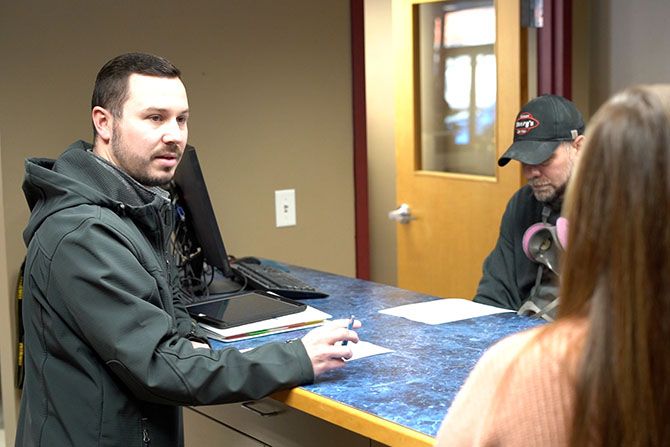Effective Safety Committee Meetings Can Have a Major Positive Impact on Corporate Culture
Since the early 1990s, businesses with more than 15 employees have been required by the New Hampshire Department of Labor (NHDOL) to conduct quarterly safety committee meetings. Starting in the late 1990s and continuing to the present day, NHADA Loss Prevention has been assisting WCT members with facilitating these meetings in an effort to enhance their effectiveness.
Let’s take a look at what the NHDOL requires, discuss the many benefits of a productive safety committee and how NHADA Loss Prevention can help.
Establishment of the Joint Loss Management Committee
- All employers of 15 or more employees shall establish a working Joint Loss Management Committee, composed of equal numbers of employer and employee representatives, or more employee representatives as follows:
- The size and composition of the Joint Loss Management Committee shall be determined as follows:
- Employers with 15 to 20 employees shall have a minimum of two members.
- Employers with more than 20 employees shall have a minimum of four members.
- Employee representatives shall be selected by the employees;
- Where the employees are represented by a single, exclusive bargaining representative, the bargaining representative shall designate the members;
- Where the employees are represented by more than one labor organization or where some but not all of the employees are represented by a labor organization, each bargaining unit of represented employees and any residual group of employees not represented shall have a proportionate number of committee members based on the number of employees in each bargaining unit or group; and
- Committee members shall be representatives of the major work activities and geographical area of the employer.
- The size and composition of the Joint Loss Management Committee shall be determined as follows:
- Committee members shall be trained in workplace hazard identification and accident and incident investigation adequately enough to carry out the committee’s responsibilities.
Duties and Responsibilities of the Joint Loss Management Committee
The Joint Loss Management Committee shall:
- Meet at least quarterly to carry out its duties and responsibilities;
- Keep minutes of meetings which shall be made available for review by all employees;
- Elect a chairperson, alternating between employee and employer representatives;
- Develop and disseminate to all employees a committee policy statement;
- Maintain current and disseminate to all employees the clearly established goals and objectives of the committee;
- Review workplace accident and injury data to help establish the committee’s goals and objectives;
- Establish specific safety programs which include, but are not limited to, the following:
- Designation, by name and title, of a person who shall be knowledgeable of site-specific safety requirements and be accountable for their implementation and adherence;
- Provisions for health and safety inspections at least annually for hazard identification purposes;
- Performance of audits at least annually regarding the inspection findings; and
- Communication of identified hazards, with recommended control measures, to the person(s) most able to implement controls.
- Assist with the identification of necessary safety and health training for employees; and
- Assist with the identification and definition of temporary, alternate tasks.
Duties and Responsibilities of the Employer
The employer shall:
- Respond, in writing, to recommendations made by the committee, or make a verbal response that is recorded in the committee’s official minutes;
- Pay any employee who participates in committee activities in the employee’s role as a committee member, including, but not limited to, attending meetings, training activities and inspections, at the employee’s regular rate of pay for all time spent on such activities; and
- Provide the required and necessary safety and health training for employees, at no cost and without any loss of pay, so they can perform their work in a safe and healthy manner and environment.
You can see there are some specific requirements, and we recommend that our members do their absolute best to comply, but what we stress the most is to establish a committee built to be productive and successful. The key to this is having decision-makers and service technicians on the team.
There are numerous benefits from an effective safety committee, starting with the impact on the culture and operation of the business. Shops look noticeably different, and there’s less turnover. You typically see the same faces every time you visit. Members with active committees tend to have fewer losses and fewer repeat injuries. This has always been important in an industry that has historically worked on very low-profit margins. When compliance issues arise, they perform better with regulators.
Safety committees create an attention to detail not just regarding safety, health and environmental issues but broach even broader operational concerns. A great example of this can be found by reviewing the Comprehensive Risk Management Checklist tool provided by NHADA Loss Prevention by clicking the link.
https://knowledge.nhada.com/comprehensive-risk-management-checklist
This checklist details nearly all regulatory requirements, best practices, training and other important programs and policies members implement to comply and reduce risk. When effectively performed, these activities send important messages and have a positive effect on the culture of the organization. Another important benefit of a committee is enhanced communication across the operation and greater awareness of company policies, procedures and expectations.
Involving NHADA Loss Prevention is crucial for a variety of important reasons, the first of which is expertise. If the state required safety professionals to establish committees to improve the process for selling and servicing autos, powersports or heavy-duty trucks, we’d be in big trouble! Likewise, it’s difficult for members to know all of the various requirements, best practices, etc. Members face regulations from OSHA, USDOL, NHDOL, DOT, EPA, NHDES and ANSI, amongst others.
Beyond the know-how, Loss Prevention also has the tools and resources that streamline compliance and the implementation of important risk management activities. Having us facilitate your safety meetings makes it a more effective and productive use of our members’ time, and you’re less likely to cancel if we are planning to attend. I should also mention that we have a software program that conveniently allows us to produce the meeting minutes, so all you have to do is print and post them!
So, if you have more than 15 employees and are not currently working with NHADA Loss Prevention to conduct quarterly safety meetings, please reach out to us at (603) 224-2369 or bduplessis@nhada.com right away to get started.







